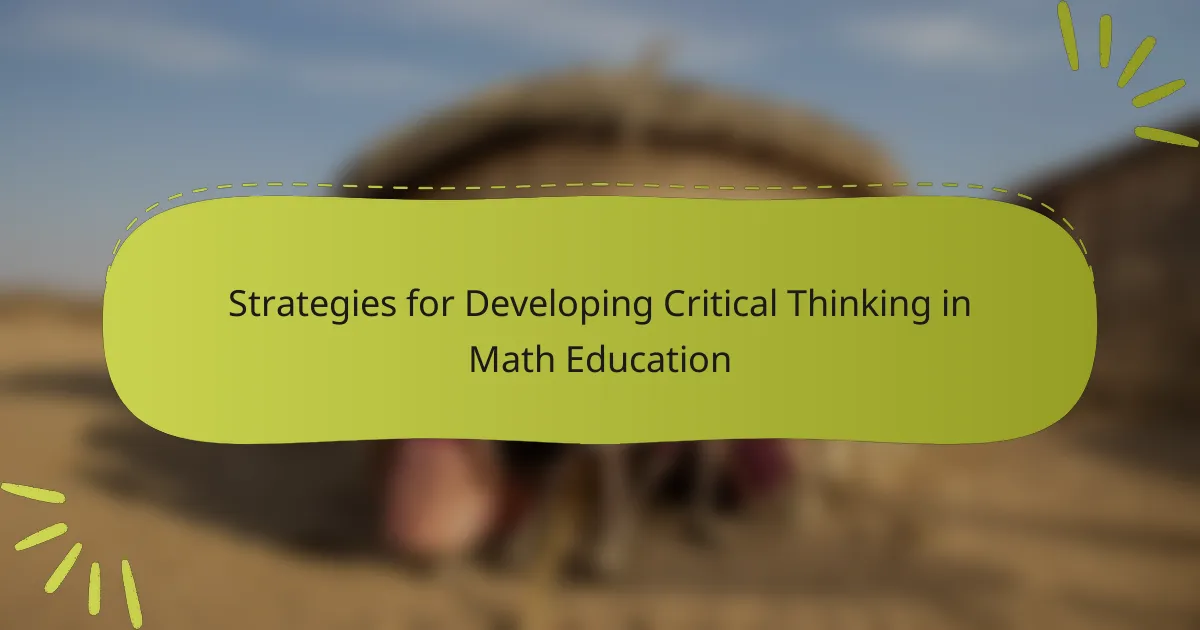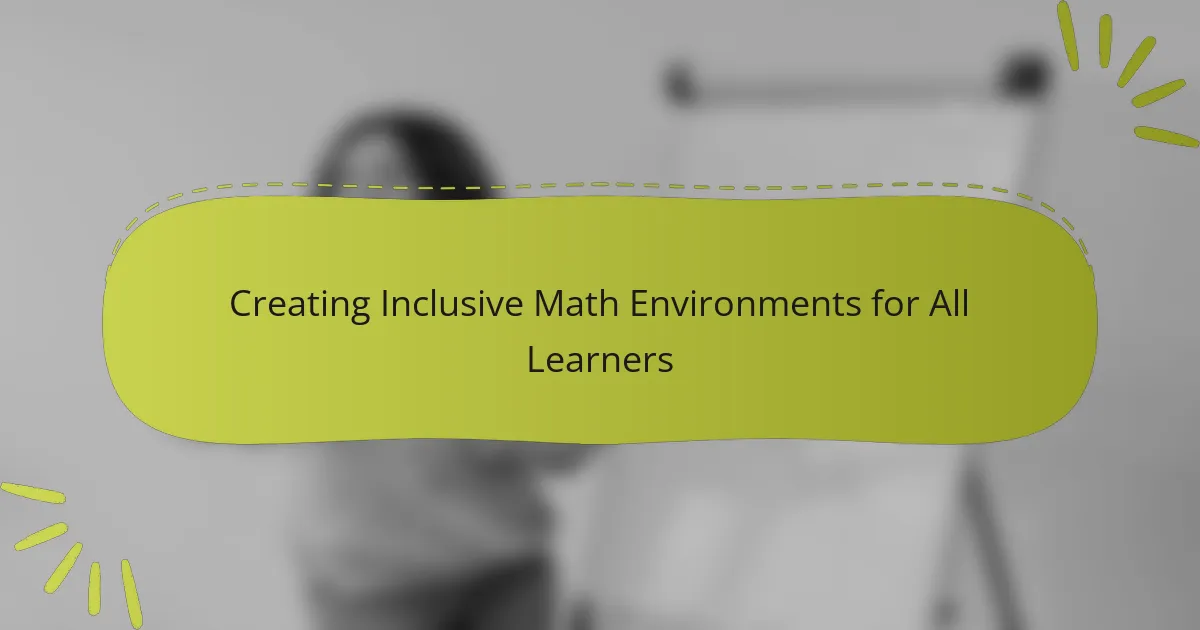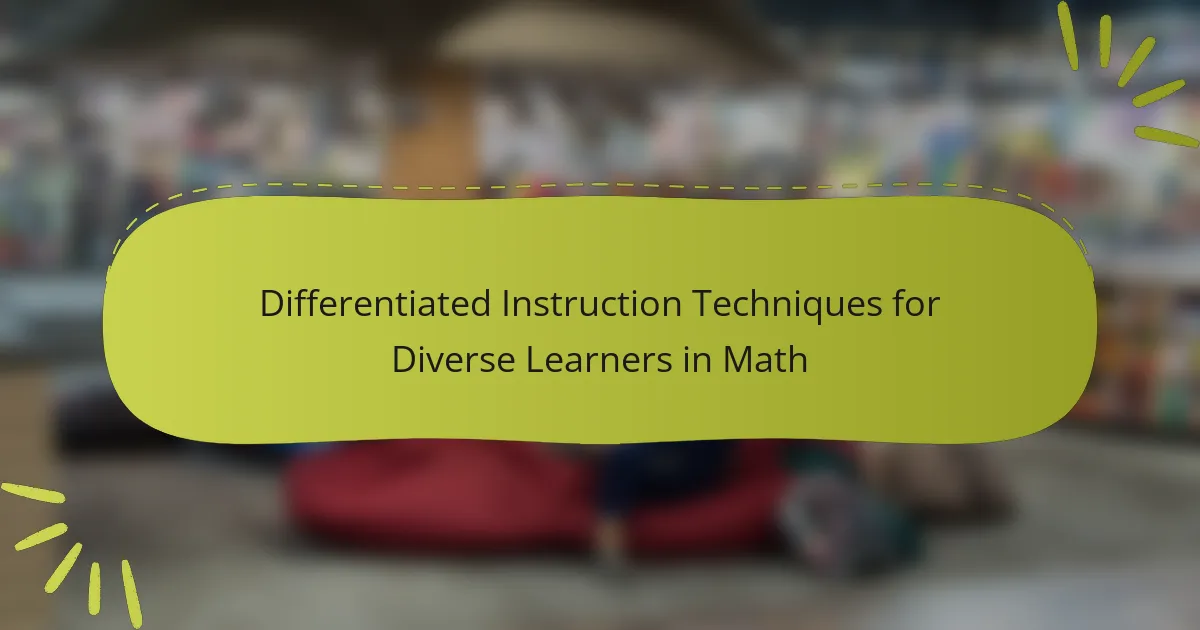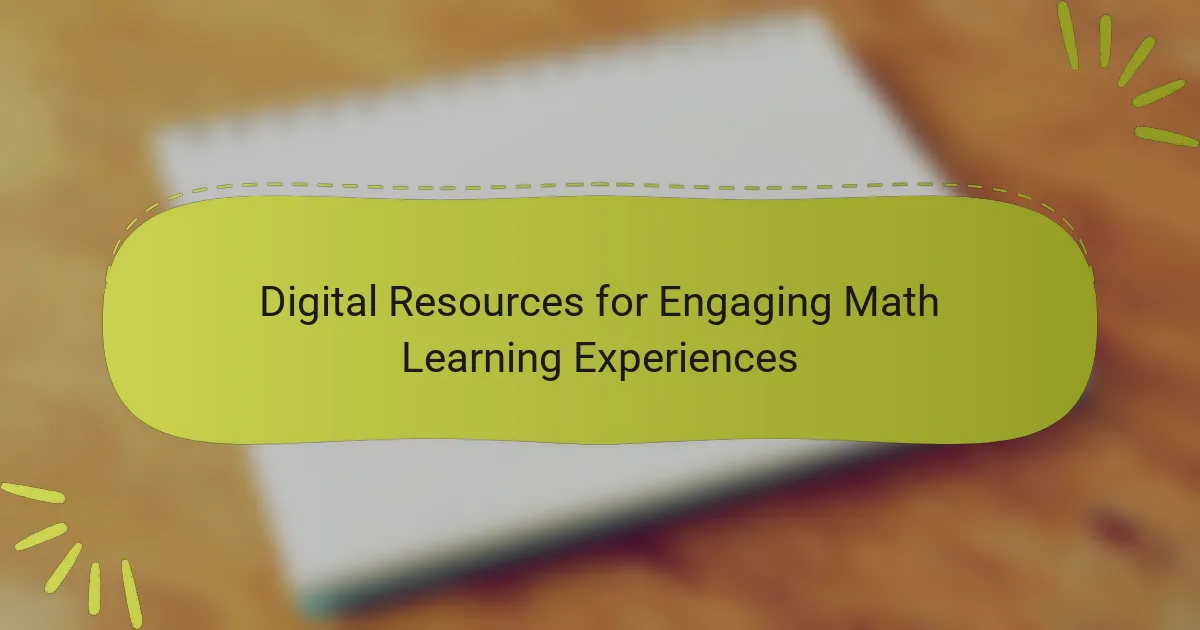Mathematics plays a crucial role in curriculum design, providing frameworks for effectively structuring educational content and addressing learning challenges. It aids educators in resource allocation, data analysis for student performance assessment, and the evaluation of educational programs through statistical methods. The integration of real-world problem-solving scenarios into lessons enhances student engagement and critical thinking skills. However, challenges such as insufficient teacher training, limited resources, and curriculum standards focusing on theoretical concepts can hinder the effective application of mathematics in educational settings. This article explores the various applications of mathematics in curriculum design and the impact on student learning outcomes.
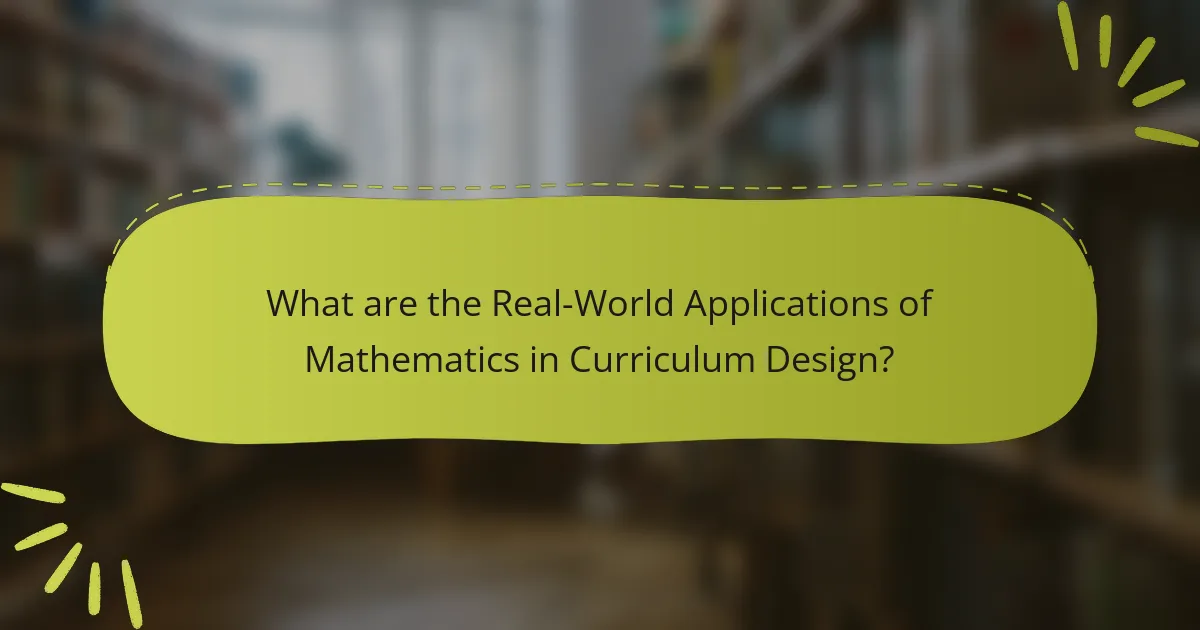
What are the Real-World Applications of Mathematics in Curriculum Design?
Mathematics has numerous real-world applications in curriculum design. It helps in structuring educational content effectively. For example, mathematical principles guide the allocation of time and resources. Educators use data analysis to assess student performance and improve teaching strategies. Curriculum designers apply statistical methods to evaluate the effectiveness of educational programs. They also utilize mathematical modeling to predict future learning outcomes. Real-world problem-solving scenarios are integrated into lessons to enhance student engagement. Furthermore, mathematics aids in creating assessments that accurately measure student understanding. Overall, mathematics is essential for developing a robust and effective curriculum.
How can mathematics be integrated into various subjects in curriculum design?
Mathematics can be integrated into various subjects in curriculum design through interdisciplinary approaches. For instance, in science classes, mathematical concepts such as statistics and graphing are essential for analyzing experimental data. In history, timelines can incorporate mathematical calculations to understand historical events’ durations and sequences.
Art classes can include geometry to explore shapes and symmetry in design. Physical education can utilize measurements and statistics to track performance and fitness levels. Additionally, economics lessons can apply mathematical models to understand market trends and financial literacy.
Research shows that integrating mathematics across subjects enhances student engagement and understanding. According to a study by the National Council of Teachers of Mathematics, students who see the relevance of math in other subjects are more likely to develop a positive attitude towards mathematics.
What are the benefits of interdisciplinary approaches in mathematics education?
Interdisciplinary approaches in mathematics education enhance student engagement and understanding. They connect mathematical concepts to real-world contexts, making learning more relevant. This relevance increases motivation and interest in mathematics. Collaborative learning occurs as students integrate knowledge from various subjects. Research indicates that interdisciplinary methods improve critical thinking skills. A study by Beers (2011) shows that students in interdisciplinary programs perform better in problem-solving tasks. Additionally, these approaches foster creativity by encouraging innovative solutions to complex problems. Overall, interdisciplinary education prepares students for real-life applications of mathematics.
How does the integration of mathematics enhance critical thinking skills?
The integration of mathematics enhances critical thinking skills by fostering logical reasoning and problem-solving abilities. Mathematics requires individuals to analyze problems, identify patterns, and develop solutions. This analytical approach encourages students to think critically about various scenarios. Research indicates that students engaged in mathematical reasoning show improved decision-making skills. A study by the National Council of Teachers of Mathematics highlights that mathematical problem-solving promotes higher-order thinking. By applying mathematical concepts to real-world situations, students learn to evaluate information critically. This skill is essential for navigating complex issues in everyday life. Therefore, mathematics serves as a foundation for developing robust critical thinking skills.
Why is it important to apply real-world scenarios in mathematics education?
Applying real-world scenarios in mathematics education is crucial for enhancing student engagement and understanding. Real-world contexts help students see the relevance of mathematical concepts in their daily lives. This relevance fosters motivation and interest in learning. Research indicates that students who engage with practical applications demonstrate improved problem-solving skills. For instance, a study by the National Council of Teachers of Mathematics highlights that contextual learning significantly boosts retention and application of mathematical skills. Additionally, students can develop critical thinking by analyzing real-life problems. This method encourages collaboration and communication among peers as they work through scenarios together. Overall, real-world applications bridge the gap between abstract concepts and practical use, making mathematics more accessible and meaningful.
How do real-world applications improve student engagement in mathematics?
Real-world applications improve student engagement in mathematics by making concepts relevant and relatable. When students see how math applies to everyday life, their interest increases. For instance, using examples from finance, architecture, or technology illustrates the practical use of mathematical principles. Research shows that students who engage with real-world problems score higher in assessments. A study by the National Council of Teachers of Mathematics found that contextual learning boosts motivation and understanding. This approach fosters critical thinking and problem-solving skills, further enhancing engagement. By connecting math to real-life scenarios, students are more likely to participate actively in lessons.
What are some examples of real-world scenarios used in mathematics curriculum?
Real-world scenarios in mathematics curriculum include budgeting for a family, calculating travel distances, and analyzing sports statistics. Budgeting teaches students to manage expenses and savings. Travel calculations help with understanding speed, distance, and time. Analyzing sports statistics fosters skills in data interpretation and probability. These examples are aligned with practical life skills. They enhance student engagement by connecting math to everyday experiences.
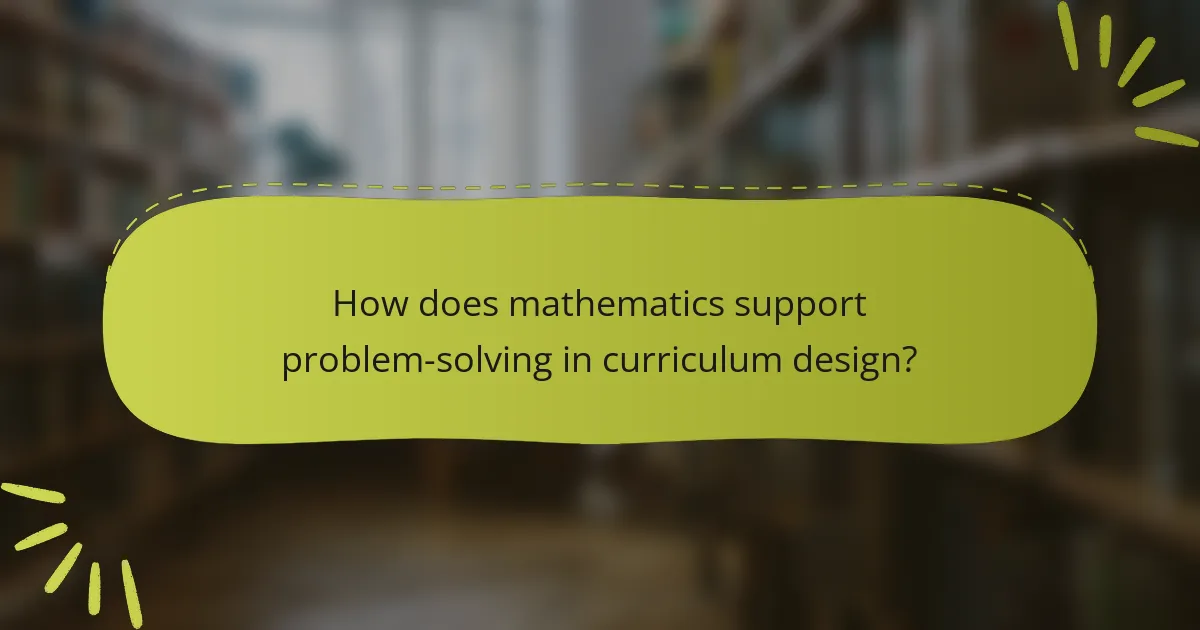
How does mathematics support problem-solving in curriculum design?
Mathematics supports problem-solving in curriculum design by providing structured frameworks for analyzing and addressing educational challenges. It enables educators to quantify learning outcomes and assess student performance systematically. Mathematical concepts such as statistics help in evaluating data from assessments. This analysis informs curriculum adjustments to meet diverse learning needs. Additionally, mathematical modeling aids in simulating real-world scenarios relevant to students. These models enhance critical thinking and foster problem-solving skills. Research shows that integrating mathematics into curriculum design leads to improved student engagement and understanding. For example, a study by the National Council of Teachers of Mathematics highlights the positive impact of data-driven decisions in educational settings.
What types of mathematical concepts are essential for effective problem-solving?
Essential mathematical concepts for effective problem-solving include algebra, geometry, statistics, and calculus. Algebra helps in forming equations and understanding relationships between variables. Geometry aids in visualizing and solving spatial problems. Statistics is crucial for data analysis and making informed decisions based on quantitative information. Calculus allows for understanding changes and modeling dynamic systems. These concepts are foundational in various real-world applications, enhancing critical thinking and analytical skills. Studies show that strong problem-solving skills are linked to proficiency in these mathematical areas, emphasizing their importance in education.
How can problem-solving strategies be taught using mathematics?
Problem-solving strategies can be taught using mathematics through structured approaches and real-world applications. Educators can introduce problem-solving frameworks, such as Polya’s four-step process: understanding the problem, devising a plan, carrying out the plan, and reviewing the solution. This method encourages critical thinking and logical reasoning.
Incorporating real-life scenarios in math lessons enhances engagement and relevance. For instance, teachers can present problems related to budgeting or construction. This context helps students see the practical use of mathematical concepts.
Collaborative learning also supports problem-solving. Group activities allow students to share diverse strategies and solutions. Peer discussions foster deeper understanding and adaptability in problem-solving.
Assessment of problem-solving skills can be integrated into math evaluations. Teachers can use performance tasks that require students to apply strategies in novel situations. This approach measures not just knowledge but the ability to think critically and solve problems effectively.
What role does mathematical reasoning play in developing problem-solving skills?
Mathematical reasoning is crucial in developing problem-solving skills. It enables individuals to analyze and interpret complex situations. This reasoning involves logical thinking and the ability to identify patterns. By applying mathematical concepts, learners can approach problems systematically. Studies show that students who engage in mathematical reasoning perform better in problem-solving tasks. For instance, research by the National Council of Teachers of Mathematics highlights the importance of reasoning in enhancing critical thinking skills. This foundation in reasoning allows for effective decision-making in real-world scenarios.
How can teachers assess students’ understanding of mathematics in real-world contexts?
Teachers can assess students’ understanding of mathematics in real-world contexts through practical applications. They can use project-based assessments where students solve real-life problems. For example, students might budget for a class event or analyze data from a local survey. Observations during these activities provide insights into students’ thought processes. Additionally, teachers can employ performance tasks that mimic real-world scenarios. These tasks require students to apply mathematical concepts to complete specific objectives. Standardized assessments can also include contextual problems that relate to everyday situations. This approach ensures that mathematics is relevant and applicable. Research shows that contextualized assessments enhance student engagement and understanding. A study by the National Council of Teachers of Mathematics supports this method, indicating that real-world applications lead to deeper comprehension.
What assessment tools are effective for evaluating real-world applications of mathematics?
Performance tasks are effective assessment tools for evaluating real-world applications of mathematics. These tasks require students to solve complex problems that mimic real-life situations. They assess not only mathematical skills but also critical thinking and problem-solving abilities. Rubrics can be used to evaluate performance tasks objectively. Projects that integrate mathematics with other subjects also provide valuable insights into students’ understanding. Portfolios allow for the collection of student work over time, showcasing growth and application of mathematical concepts. Standardized tests may also include real-world scenarios to assess students’ practical math skills. Research indicates that authentic assessments lead to deeper learning and retention of mathematical concepts.
How does formative assessment contribute to student learning in mathematics?
Formative assessment enhances student learning in mathematics by providing ongoing feedback. This feedback allows educators to identify student strengths and weaknesses in real-time. It helps tailor instruction to meet individual learning needs. Research indicates that formative assessment can lead to improved student performance. A study by Black and Wiliam (1998) found that formative assessment significantly boosts academic achievement. Additionally, it encourages student engagement and motivation. Students who receive regular feedback are more likely to take ownership of their learning. Overall, formative assessment is a critical tool for effective mathematics instruction.
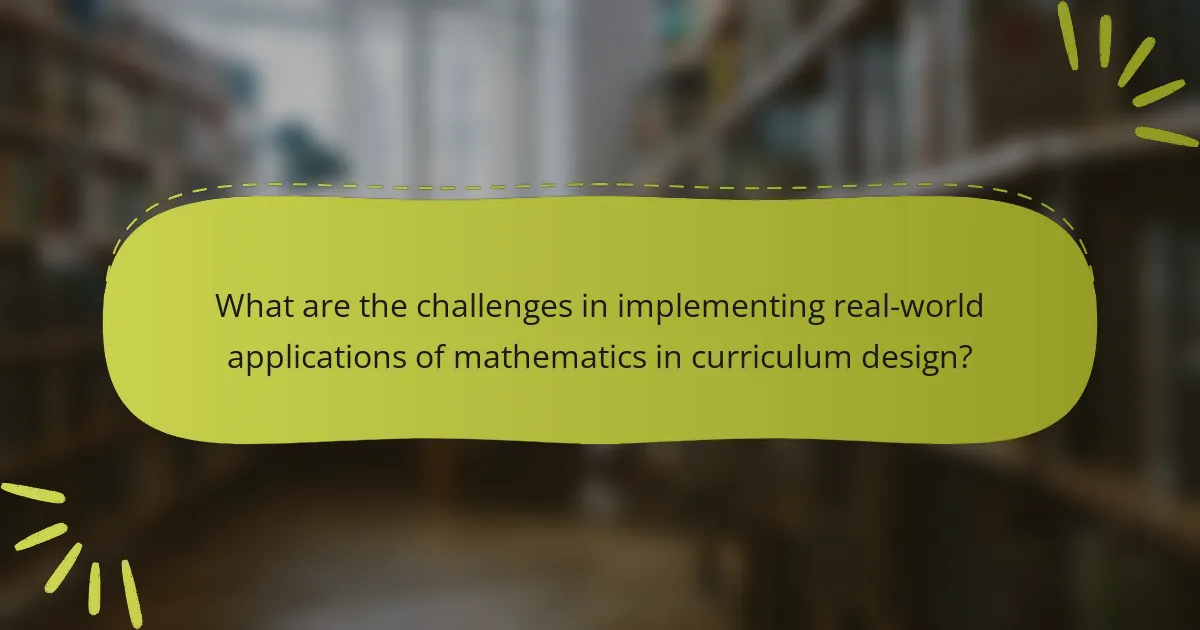
What are the challenges in implementing real-world applications of mathematics in curriculum design?
Challenges in implementing real-world applications of mathematics in curriculum design include lack of teacher training. Many educators are not equipped to teach applied mathematics effectively. Limited resources also hinder the integration of real-world problems into lessons. Curriculum standards often emphasize theoretical concepts over practical applications. Additionally, standardized testing may not assess real-world problem-solving skills. Time constraints in the curriculum limit opportunities for hands-on learning. Finally, varying student backgrounds can affect engagement with real-world applications. These factors collectively complicate the effective teaching of mathematics in a relevant context.
What barriers do educators face when integrating real-world applications into mathematics teaching?
Educators face several barriers when integrating real-world applications into mathematics teaching. These barriers include lack of resources, insufficient training, and rigid curriculum standards. Many educators report limited access to materials that connect math to real-life scenarios. A study by the National Council of Teachers of Mathematics found that 70% of teachers feel unprepared to teach applied mathematics. Additionally, teachers often receive inadequate professional development focused on real-world integration. Curriculum standards may restrict flexibility, making it challenging to incorporate practical applications. Time constraints also limit opportunities for project-based learning. These factors collectively hinder effective integration of real-world applications in mathematics education.
How can professional development support teachers in overcoming these challenges?
Professional development can support teachers in overcoming challenges by providing targeted training and resources. It equips teachers with innovative strategies for integrating real-world applications of mathematics into their lessons. Access to workshops and collaborative learning opportunities enhances teachers’ problem-solving skills. Research shows that effective professional development improves teachers’ confidence and instructional practices. A study by the National Staff Development Council found that well-designed programs lead to increased student engagement and achievement. Continuous support and feedback from peers and mentors further facilitate teachers’ growth. Ultimately, professional development fosters an environment of lifelong learning and adaptation to educational challenges.
What resources are available to assist in the integration of real-world mathematics applications?
Resources available to assist in the integration of real-world mathematics applications include online platforms, textbooks, and professional development workshops. Online platforms like Khan Academy and Coursera offer courses that connect mathematical concepts to real-life scenarios. Textbooks such as “Mathematics in Real Life” provide examples and exercises that apply math to everyday situations. Professional development workshops help educators learn strategies for incorporating real-world applications into their teaching. Additionally, organizations like the National Council of Teachers of Mathematics (NCTM) provide guidelines and resources for effective curriculum design. These resources support educators in making mathematics relevant and engaging for students.
What best practices can enhance the effectiveness of mathematics curriculum design?
Effective mathematics curriculum design can be enhanced through several best practices. First, integrating real-world applications makes learning relevant. This approach helps students connect mathematical concepts to everyday life. Second, employing differentiated instruction caters to diverse learning styles and paces. Research shows that personalized learning increases student engagement and understanding. Third, utilizing technology, such as interactive software, supports innovative teaching methods. Studies indicate that technology can enhance problem-solving skills. Fourth, fostering collaboration through group work encourages peer learning. Collaborative environments have been linked to improved critical thinking. Lastly, continuous assessment informs instruction and identifies areas for improvement. Regular feedback allows educators to adapt their teaching strategies effectively.
How can collaborative learning environments improve mathematics education?
Collaborative learning environments can significantly enhance mathematics education by fostering peer interaction and engagement. These environments encourage students to discuss mathematical concepts, which deepens their understanding. Research shows that students who collaborate often perform better academically. A study by Johnson and Johnson (1999) found that cooperative learning leads to higher achievement in mathematics. Additionally, collaborative settings promote critical thinking skills. Students learn to approach problems from various perspectives when working together. This diversity of thought enhances problem-solving abilities. Furthermore, collaboration helps build communication skills essential for expressing mathematical ideas. Overall, collaborative learning environments create a supportive atmosphere that benefits mathematics education.
What strategies can educators use to make mathematics relevant to students’ lives?
Educators can use real-world applications to make mathematics relevant to students’ lives. They can incorporate examples from everyday situations, such as budgeting or cooking. This helps students see the practical use of math in their routines. Project-based learning can also be effective. Students can engage in projects that require mathematical reasoning, such as building models or conducting surveys. Collaborating with local businesses can provide students with insights into how math is used in various careers. Using technology, like math-focused apps or online simulations, can enhance engagement. Additionally, integrating math into subjects like science or art can show its interdisciplinary nature. These strategies help students relate mathematics to their personal experiences and future aspirations.
What tips can educators use to effectively apply mathematics in curriculum design?
Educators can effectively apply mathematics in curriculum design by integrating real-world applications into lessons. This approach enhances student engagement and understanding. For instance, using data from local businesses can make statistics relevant. Incorporating project-based learning allows students to solve practical problems. Collaborating with community organizations can provide authentic contexts for mathematical concepts. Utilizing technology, such as simulations, can also enhance learning experiences. Research shows that contextual learning improves retention and application of mathematical skills. According to a study by the National Council of Teachers of Mathematics, real-world connections increase student interest and motivation in mathematics.
The main entity of this article is the real-world applications of mathematics in curriculum design. The article explores how mathematics is integral to structuring educational content, enhancing student engagement, and improving teaching strategies through data analysis and statistical methods. It discusses the integration of mathematics across various subjects, the benefits of interdisciplinary approaches, and the importance of applying real-world scenarios to foster critical thinking and problem-solving skills. Additionally, it addresses challenges educators face in implementing these applications and highlights effective strategies and resources for enhancing mathematics education.
